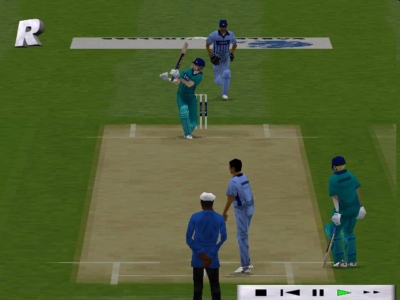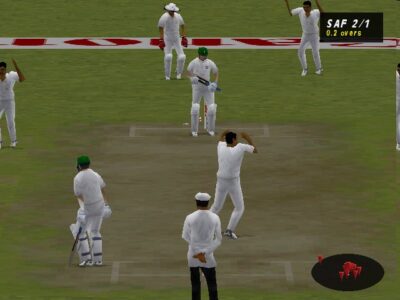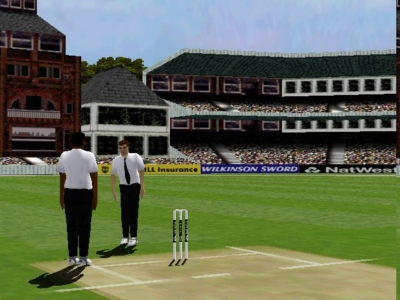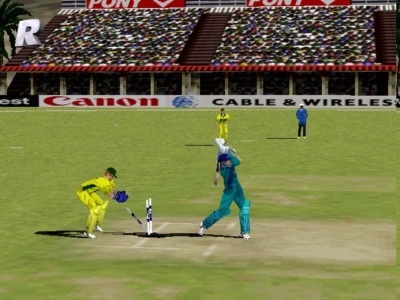
Brian Lara Cricket
Written by: Rik
Date posted: March 5, 2007
- Genre: Sport
- Developed by: Codemasters
- Published by: Codemasters
- Year released: 1999
- Our score: 4
A little while ago, we reviewed a decent little game called International Cricket Captain 2, and gave it a vaguely positive review: although hardly ground-breaking stuff, and nowhere near as detailed or addictive an experience as something like Championship Manager, it’s a well put together game which works pretty well and should keep those with even a passing interest in the tactics and management of cricket entertained for a good few hours. One thing ICC2 doesn’t do, however, is give you the chance to get out on the pitch and become directly involved with the action.
In one way, this could be seen as a disappointing oversight – but in fact, this is actually the game’s saving grace. As cricket game fans will know only too well, virtually every title ever released that has given the player the opportunity to ‘hit the opposition for six!’ (or whatever other terrible cricketing cliché the publishers decided to put on the box) has been fundamentally flawed in one way or another. Even the latest cricket titles, while superficially impressive, are released with some glaring errors and omissions evident.
Brian Lara Cricket raised the bar for cricket titles (or rather, it dragged them kicking and screaming into the modern era) by being the first to feature 3D-accelerated polygon graphics, along with all the other technical wizardry evident in other sports titles of the era (such as FIFA). After some of the dross that had come and gone over the years (such as endless rehashes of Audiogenic’s ancient World Class Cricket series), for once it actually looked as if some thought and effort had been put into developing a brand new, modern and fully-featured cricket game – and it had cricket fans licking their lips.
Even now, the list of features is impressive: all the major international teams are featured, each with authentic line-ups (with statistics and averages provided by Cricinfo). You can play in Test series, one-day internationals (including the Cricket World Cup) or even play a series of challenges based on famous real-life matches from the history books. All the major international stadiums are faithfully rendered in 3D, with pitch and weather conditions changing to reflect where the match is being played (i.e. in Lahore it will be hot and humid, while any games played at Headingley will most likely be affected by rain).

If you press the ‘six hit’ button, the batsman attempts to give it a bit of welly. Time it right, and it’s runs, if not, well, it just goes miles up in the air. Which is what’s happened here.
Once you get out on the pitch, the first thing to note is that the polygon graphics now look pretty dated. BLC was also released on the original PlayStation, and it wouldn’t be unfair to say that, bar a slightly crisper resolution and a few extra 3D effects, the PC version is pretty much a straight port. While the animations are still reasonably impressive, the player models are extremely basic, with hands and feet looking particularly angular, and players are distinguished from each other only by skin and hair colour. It should also be noted that the game comes from the era of 3dfx dominance, and hence the Glide version is much more visually impressive than the Direct3D version that most modern PCs will be much happier with. Sound-wise, the various crowd noises and sound effects still do the job, and the commentary, provided by BBC stalwarts Jonathan Agnew and Geoffrey Boycott, is pretty well done.
In terms of gameplay, ‘solid but unspectacular’ might be the best way to describe it. On the positive side of things, there are no glaring errors or bugs, no horrendous shortcomings that render the game unplayable, and no horrible AI errors that at least mean the computer always gives you a decent game. While this may be damning the game with faint praise, the fact is that it does actually all hang together, which is more than can be said for other more recent titles.
Unfortunately, though, BLC isn’t actually that much fun to play. The game of cricket, at its best, can be a fascinating game to watch, full of unpredictable twists and turns, with occasional moments of brilliance turning a match on its head in the space of a few balls. Games of BLC, meanwhile, are fairly turgid, unremarkable affairs, with the whole experience resembling a real-life cricket hater’s version of the game – a boring, largely-pointless game which goes on for far too long.
Both batting and bowling will test even the most resolute gamer’s patience. While at the crease, a marker on the pitch appears to tell you where the ball will be bowled before the bowler has even started his run-up, which means you can decide which shot to play long before the ball is delivered – the only challenge remaining being to execute the shot with some degree of timing. While bowling, there are very few variations at your disposal, especially with fast bowlers, and you’re quickly reduced to bowling the ball in the same area time and time again (again, no real challenge) and hope for some kind of result.
Most of the subtleties of the real-life game are sadly missing here. In the one-day game, there’s no opportunity for players to take calculated risks by trying to do something out of the ordinary – a batsman moving out of his crease to try and play an aggressive stroke or a bowler attempting a vicious, inswinging yorker, for example. Instead, the game remains a fairly static affair, with the computer artificially increasing scoring rates early on by making fairly unambitious shots whistle to the boundary, before tightening up and punishing aggressive strokes with the loss of a wicket later on. In Test matches, meanwhile, there are very few options for fast and medium-fast bowlers to actually do anything with the ball, such as move it off the seam or swing it through the air, and any wickets that come your way never seem to be the direct result of anything you’ve done.
To non-cricket fans, that last paragraph may not have made a lot of sense, so let me try and put it another way. Essentially, Brian Lara Cricket is a very simple game, while real-life cricket is not. So instead of attempting to simulate all the intricacies of the sport, BLC artificially creates events like hitting boundaries and losing wickets by sprinkling them, almost at random, throughout the game. Sometimes you can play the ‘right’ shot to a particular ball, but if the computer decides it’s time for you to get out, you’re going to get out. The same goes for when you’re bowling; as I’ve already mentioned, you never feel like you’ve actually done anything special to get a wicket – more that the computer has decided it’s time for you to get one. Overall, the whole things has a deeply-unsatisfying ‘on-rails’ feeling which ultimately makes for a quite unrewarding experience.
Still, there are some people out there in internet-land who are quite happy to make the claim that BLC remains the best cricket game you can play. In a way, they’ve got a point: while more recent titles certainly have the potential for a more exciting game of cricket, the progress made in terms of new technology and gameplay innovations is usually undermined by some fairly basic flaws. Ultimately, that’s the choice you’re faced with as a cricket games fan – with no definitive title out there, it’s a question of weighing up which shortcomings you’re best able to put up with. Personally speaking, I’d much rather play a game that at least tries to replicate some of the intricacies and subtleties of my favourite sport rather than something that takes the easy option by doing away with them altogether.





 Posts
Posts